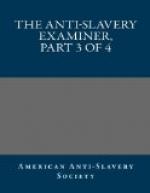common number of lashes inflicted was fifty or eighty;
and this I saw not once or twice, but so frequently
that I can not tell the number of times I have seen
it. So frequently, that my own heart was becoming
so hardened that I could witness with comparative
indifference, the female writhe under the lash, and
her shrieks and cries for mercy ceased to pierce my
heart with that keenness, or give me that anguish
which they first caused. It was not always that
I could learn their crimes; but of those I did learn,
the most common was non-performance of tasks.
I have seen men strip and receive from one to three
hundred strokes of the whip and paddle. My studies
and meditations were almost nightly interrupted by
the cries of the victims of cruelty and avarice.
Tom, a slave of Col. N. obtained permission of
his overseer on Sunday, to visit his son, on a neighboring
plantation, belonging in part to his master, but neglected
to take a “pass.” Upon its being demanded
by the other overseer, he replied that he had permission
to come, and that his having a mule was sufficient
evidence of it, and if he did not consider it as such,
he could take him up. The overseer replied he
would take him up; giving him at the same time a blow
on the arm with a stick he held in his hand, sufficient
to lame it for some time. The negro collared him,
and threw him; and on the overseer’s commanding
him to submit to be tied and whipped, he said he would
not be whipped by
him but would leave it to
massa J. They came to massa J.’s. I was
there. After the overseer had related the case
as above, he was blamed for not shooting or stabbing
him at once.—After dinner the negro was
tied, and the whip given to the overseer, and he used
it with a severity that was shocking. I know
not how many lashes were given, but from his shoulders
to his heels there was not a spot unridged! and at
almost every stroke the blood flowed. He could
not have received less than 300,
well laid on.
But his offence was great, almost the greatest known,
laying hands on a
white man! Had he struck
the overseer, under any provocation, he would have
been in some way disfigured, perhaps by the loss of
his ears, in addition to a whipping: or he might
have been hung. The most common cause of punishments
is, not finishing tasks.
[Footnote 14: A piece of oak timber two and a
half feet long, flat and wide at one end.]
“But it would be tedious mentioning further
particulars. The negro has no other inducement
to work but the lash; and as man never acts
without motive, the lash must be used so long as all
other motives are withheld. Hence corporeal punishment
is a necessary part of slavery.
“Punishments for runaways are usually severe.
Once whipping is not sufficient. I have known
runaways to be whipped for six or seven nights in
succession for one offence. I have known others
who, with pinioned hands, and a chain extending from
an iron collar on their neck, to the saddle of their
master’s horse, have been driven at a smart
trot, one or two hundred miles, being compelled to
ford water courses, their drivers, according to their
own confession, not abating a whit in the rapidity
of their journey for the case of the slave. One
tied a kettle of sand to his slave to render his journey
more arduous.




